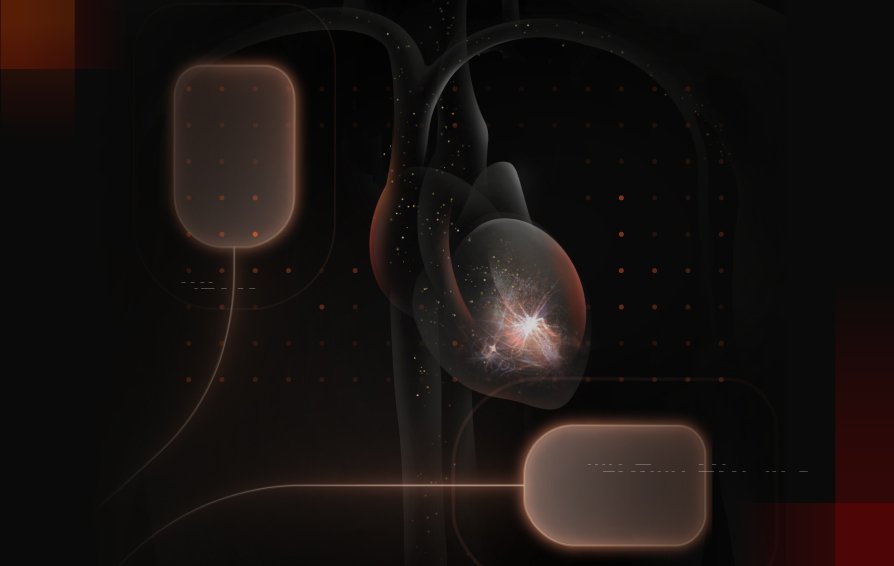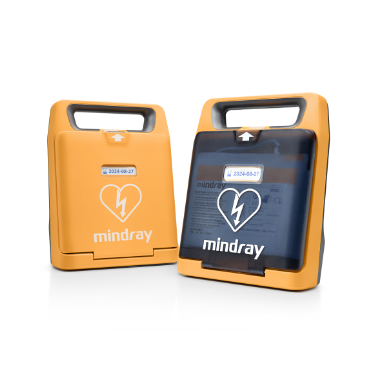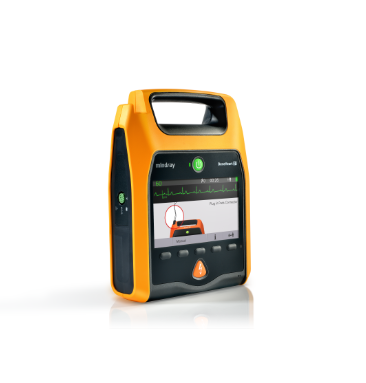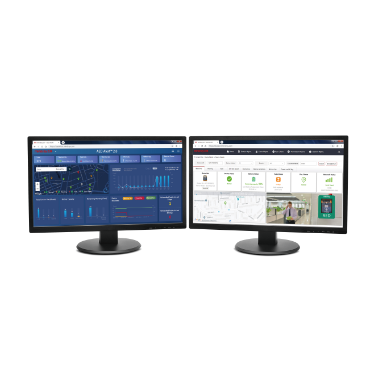Sudden Cardiac Arrest (SCA) is a major cause of death worldwide, estimated to kill one person every 5 seconds. 90% of SCA cases occur in public areas outside the hospital, making timely first-aid difficult and thereby often accompanied by patient death.
This is where Mindray has started its journey of advancing and promoting AED solutions. "We were focusing only on the in-hospital defibrillators at the time. But as we went deeper, we came to realize that more should be done for out-of-hospital challenges as well," R&D team of Mindray AED recalled. From in-hospital defibrillation to AED, although there are many obstacles along the way, it has brought new inspiration to Mindray and the market.
Undefinable User Group? Adaptation Rather Than Restriction
Unlike in-hospital medical devices, Automated External Defibrillator (AED) users may come from different industries, age groups and gender, with different levels of first-aid training and cultural literacy. Looking at a bigger picture, the public awareness and familiarity with AED vary greatly from place to place across the globe, with a penetration rate of first-aid knowledge being less than 1% in the Chinese mainland and greater than 50% in many developed countries by 2022.
As the R&D team explained, "For healthcare providers, they know exactly what tools and functions they need for medical devices. But when it comes to ordinary people, many don't know what kind of AED they need." How to develop an AED device that can satisfy "everyone's need"? This has become the biggest challenge faced by Mindray's AED R&D team at the beginning of the project in 2011.
A user's proficiency in using AED is most typically demonstrated by their dependence on voice prompts. In a large number of surveys and simulated clinical trial observations among different populations, Mindray's R&D team has found that for an experienced user, only simple prompts are needed during the rescue, and excessive voice prompts may slow the first-aid pace and affect the first-aid efficiency; while for a rescuer without first-aid experience, detailed explanations and guidance of each step are absolutely necessary for assurance in a stressful first-aid process.

Mindray AED R&D team
This was also the biggest problem of AED products we found on the market at the time, when was that there was only a fixed set of voice prompts that could not match with the proficiency of different user groups.
Mindray did not ask users to define their own operational proficiency, as the results from a large number of user behavior and psychological studies have shown that users might be deceived by themselves. ResQNavi™, an intelligent first-aid navigation system, is an all-new way to auto-adapt to a rescuer's proficiency by monitoring, analyzing and identifying user behaviors, and by smartly matching rescuers with different patterns of guidance based on user interactions in first-aid processes.
Taking electrode pads as an example. For skilled rescuers, Mindray's AED just provides a simple prompt "remove clothing from patient's chest and apply pads as shown". New hands, however, may not be aware that they need unpacking or how to connect the pads securely in a stressful and confused state. So, when they are identified by ResQNavi technology, the current prompt will be automatically upgraded to provide more detailed guidance and emphasize key prompts with accents: "Remove pads package from lid of AED. Tear open package. Apply pads as shown on pads…"


From Unfamiliarity to Trust: Capturing Subconscious Habits
Facing death calmly is not easy for an ordinary person. Hurry and confusion, stress and slowness are very normal. "In a simulated clinical trial, some study subjects even could not find the power key in a hurried and confused state," added Mindray's R&D team.
At this critical moment, AED is perceived as not just a simple first-aid tool, but a good partner and supporter alongside. How to quickly build trust and improve users' confidence in the effectiveness of AED and his/her ability to successfully save a patient's life? "Single-Threaded Thought" and "Positive Feedback" are two keywords given by Mindray's R&D team and are present throughout the design of the first-aid process with Mindray's AED.
"It is our common sense that when one gets a box, the first thing they instinctively do is to open its lid." Mindray's latest BeneHeart C series, therefore, uses a flip design by canceling the power key, and the device will immediately turn on when lid is opened. AED device also simultaneously sends a voice prompt "the device has turned on, please remain calm and follow the voice prompts" to give positive feedback the first time, building up a user's initial confidence and trust to guide the following first-aid process smoother.

Mindray AED Sales Manager
Do not look down upon these two simple small designs. Many of clients shared with us in AED training that this design makes people feel at ease a lot when having turned on the device and hearing this power-on prompt.
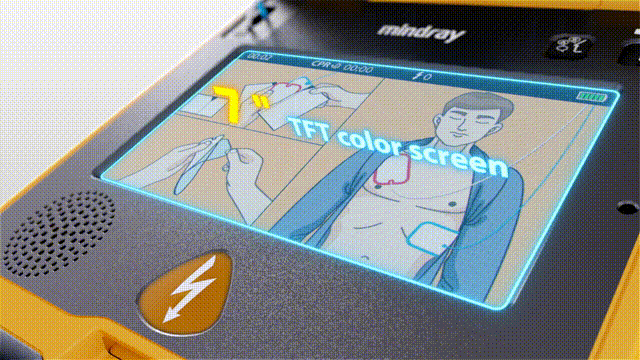
After start-up, continuous "Positive Feedback" helps Mindray's BeneHeart C-series AEDs better interact with users. An AED user may be hesitant during first aid, mostly because they are unconsciously seeking feedback to determine if they are operating it correctly. Mindray's BeneHeart C series is initiatively added with a 7'' large color screen with step-by-step animation guidance for more directive and intuitive visual feedback, which together with flexible voice prompts, provides more clear guidance for users and helps improve confidence in a stressful rescue. This considerate design also leads the industry to a big-screen AED trend.
A Marathon to Race Against the Time: Highlight of Both Speed and Quality
For SCA patients, the golden time of rescue is only 4-6 minutes. "A patient's ventricular fibrillation starts with coarse ECG waveforms which then turns to fine and slow. Myocardium becomes less viable due to ischemia and the heart rhythm is less likely to be restored over time," explained the R&D team.

Typical ECG trend when SCA occurs
Statistics have shown that cardio-pulmonary resuscitation of a patient within 4 minutes after SCA results in a successful rescue rate of approximately 50%, or even up to 90% if combined with AED for electric defibrillation.
Therefore, every second is critical to rescue an SCA patient.
The latest QShock™ technology adopted in Mindray's AED, with ECG analysis concurrently performed with intelligent pre-charge, takes less than 8 seconds from start-up to completion of shock delivery, effectively improving the successful defibrillation rate. It is based on the advantages of ECG analysis technology accumulated over the years and the support of a large amount of clinical data. This breakthrough of Mindray's arrhythmia analysis algorithm enables Mindray's AEDs to achieve an industry limit of 5-second analysis while ensuring the best accuracy.

Single defibrillation often cannot restore the normal heart rhythm of SCA patients immediately. To ensure that human organs are still provided with a certain amount of oxygenated blood during rescue for the subsequent defibrillation and other treatment, continuous external chest compressions are necessary. But this also places higher requirements on rescuers -- perform 100 - 120 compressions per minute and press down by 5 to 6 cm to ensure good blood circulation throughout the body.
How to ensure a rescuer's quality of compression when he or she is tired? The AED R&D team has been inspired by daily life -- make AED a "CPR coach" for rescuers by reminding rescuers to adjust their movements timely through voice prompts like "100 compressions left, 50 compressions left... please press hard and continuously" to encourage them to complete high-quality compressions before emergency medical services arrive.

First-aid trainer in Europe
Every rescuer needs to provide at least 200 compressions even in 2-minute rotation, and a rescuer's quality of compression tends to decline significantly over time.
Much of the time, there is only an uncomplicated series of movements between life and death. Improving the effectiveness of these movements relies on continuous innovations of practitioners in making first-aid tools like AED more intelligent and supportive so that every individual is confident to act.
Medical innovation is never apart and above or unsearchable. Through keen, sophisticated and innovative insights and technological exploration, Mindray's AED has enabled even non-professionals to harness the full power of specialized devices to save lives.
